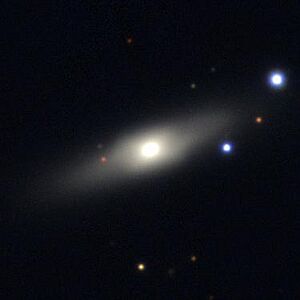NGC 714 facts for kids
NGC 714 is a fascinating galaxy located in the constellation of Andromeda. It is a special type of galaxy known as a lenticular galaxy. This means it looks a bit like a lens or a flat disk. NGC 714 is incredibly far away from Earth, about 190 million light-years distant.
Contents
What is NGC 714?
NGC 714 is a galaxy, which is a huge collection of stars, gas, dust, and dark matter, all held together by gravity. Our own solar system, including Earth, is part of a galaxy called the Milky Way. There are billions of galaxies in the universe, and NGC 714 is one of them.
A Lenticular Galaxy
Galaxies come in different shapes. Some are spiral, like the Milky Way, with long arms swirling around a center. Others are elliptical, looking more like giant, fuzzy balls. A lenticular galaxy, like NGC 714, is a mix between these two. It has a bright central bulge and a flat disk, but it doesn't have the clear spiral arms that spiral galaxies do. Imagine a frisbee or a lens, and you'll have a good idea of its shape.
Where is it Located?
NGC 714 is found in the constellation of Andromeda. A constellation is a group of stars that appear to form a pattern in the night sky when viewed from Earth. The Andromeda constellation is famous for containing the Andromeda Galaxy, which is the closest large galaxy to our Milky Way. NGC 714 is also in this direction, but it is much farther away than the Andromeda Galaxy itself.
How Far Away is it?
When we say NGC 714 is about 190 million light-years away, it means the light we see from it today started its journey 190 million years ago! A light-year is a way to measure huge distances in space. It's the distance light travels in one year. Since light travels incredibly fast (about 300,000 kilometers per second), 190 million light-years is an enormous distance, showing just how vast the universe is.
Discovery of NGC 714
NGC 714 was discovered in the year 1850. It was first observed by an astronomer named Bindon Blood Stoney. He was a scientist who spent time looking at the night sky and mapping out celestial objects. His discovery helped add to our understanding of the many galaxies that exist beyond our own.


